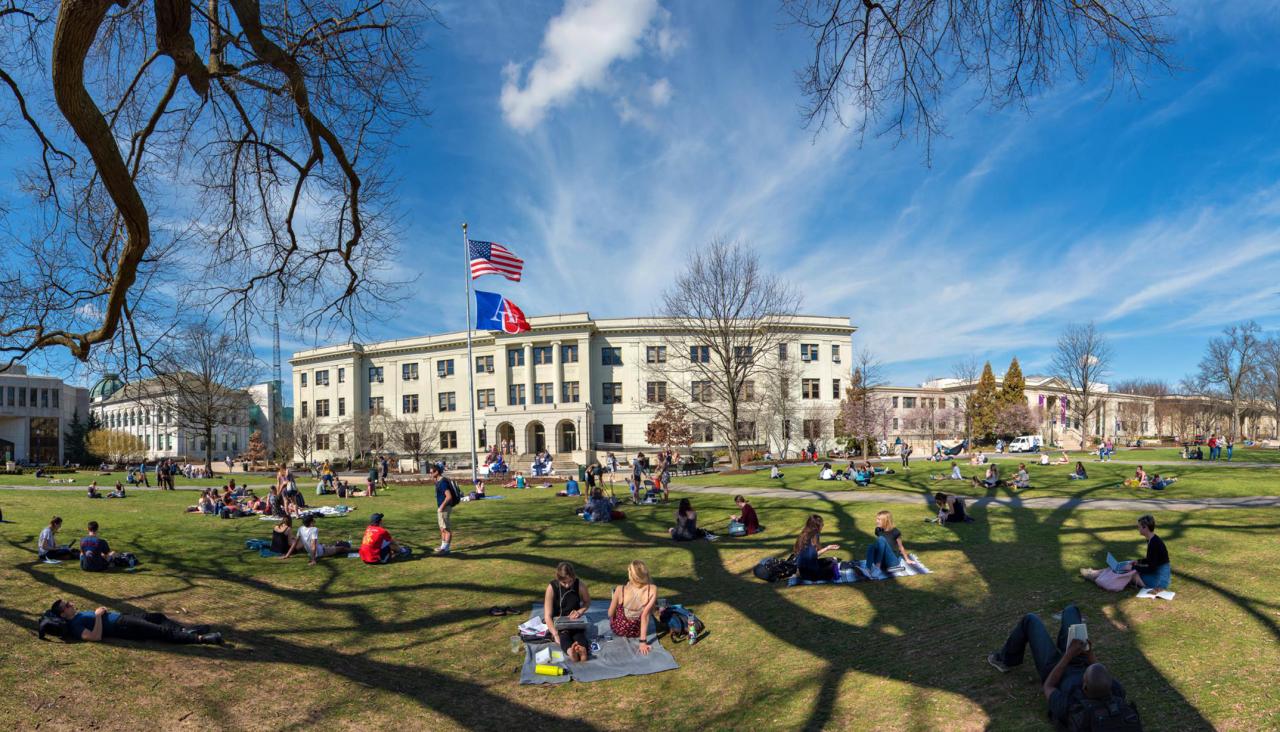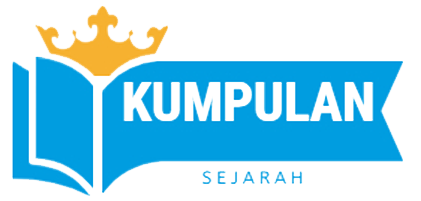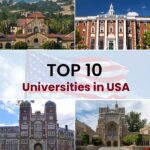American University News unveils a dynamic landscape of higher education, encompassing evolving admissions trends, the crucial role of research funding, the impact of student activism, the influence of athletics, and the transformative power of technology. This exploration delves into the complexities of curriculum evolution, diversity and inclusion initiatives, globalization’s impact, and the crucial link between career services and graduate employment outcomes. The narrative paints a comprehensive picture of the challenges and triumphs shaping the future of American universities.
From analyzing shifting acceptance rates at prestigious institutions to examining the effectiveness of online learning platforms and the economic impact of successful athletic programs, this overview provides a multifaceted perspective on the contemporary American university experience. We’ll explore how universities are adapting to a changing world, fostering diversity, and preparing graduates for success in a globalized marketplace.
The Role of Athletics in American University Culture: American University News

College athletics in the United States play a multifaceted role, extending far beyond the playing field. They significantly impact the financial landscape of universities, influence institutional prestige, and shape the overall campus culture. The relationship between academics and athletics is complex, with successful athletic programs often intertwining with, and sometimes even driving, a university’s overall reputation and financial stability.
Economic Impact of Successful Athletic Programs
Successful athletic programs can generate substantial revenue for American universities. This revenue stems from various sources, including ticket sales, media rights, merchandise sales, and donations from alumni and boosters. However, these programs also incur significant expenses related to coaching salaries, player scholarships, facility maintenance, and travel. The net financial impact varies considerably depending on the sport, the level of success, and the university’s overall financial management.
| Revenue Source | Typical Revenue (Millions USD) | Typical Expenses (Millions USD) | Net Financial Impact (Millions USD) |
|---|---|---|---|
| Ticket Sales | 5-20 | – | 5-20 |
| Media Rights (TV, Streaming) | 10-50+ | – | 10-50+ |
| Merchandise Sales | 2-10 | 2-5 (Production, Distribution) | 0-8 |
| Donations/Sponsorships | 5-30+ | – | 5-30+ |
| Total Revenue | 22-110+ | 2-5 | 20-105+ |
*Note: These figures are estimates and can vary significantly depending on the university, the sport, and the level of success.* For example, a major football program at a large public university might generate significantly more revenue than a smaller university’s basketball program. Conversely, expenses can be equally variable, with larger programs often requiring more extensive facilities and support staff.
Athletic Success and University Prestige
A strong correlation exists between athletic success and increased university prestige. National championships and consistent high rankings in major sports can attract more prospective students, faculty, and donors. This increased visibility enhances the university’s reputation, boosting applications and attracting high-achieving students. The positive media attention associated with athletic success also indirectly benefits other aspects of the university, contributing to a more positive overall image. This heightened profile can lead to increased research funding and philanthropic contributions, further benefiting the institution.
Examples of Universities Balancing Academics and Athletics
Several universities have successfully integrated academic excellence with athletic achievement. Stanford University consistently ranks highly in both academic rankings and athletic performance across multiple sports. Duke University, known for its strong academic programs, also boasts successful basketball and other athletic teams. These institutions demonstrate that a commitment to both academic rigor and athletic success is achievable, often leveraging the positive synergies between the two. The success of these institutions illustrates that a robust athletic program can be a valuable asset to a university, provided it’s managed effectively and integrated thoughtfully into the overall institutional strategy.
Technological Advancements and American University Education
The integration of technology has fundamentally reshaped the landscape of American university education, impacting teaching methodologies, student engagement, and access to learning resources. From sophisticated learning management systems to advanced digital tools, technology has become an integral part of the modern university experience. This evolution presents both opportunities and challenges, demanding a nuanced understanding of its impact on various aspects of higher education.
The proliferation of online learning platforms and digital tools has dramatically altered how universities deliver instruction. Learning Management Systems (LMS) like Canvas, Blackboard, and Moodle serve as central hubs for course materials, assignments, communication, and assessment. These platforms facilitate asynchronous learning, allowing students to access content and engage with instructors and peers at their convenience. Beyond LMS, digital tools such as interactive simulations, virtual labs, and educational apps enrich the learning experience, providing students with engaging and immersive learning environments. Moreover, the rise of open educational resources (OER) provides cost-effective alternatives to traditional textbooks, broadening access to quality educational materials.
Effectiveness of Traditional vs. Online Learning Across Disciplines
The effectiveness of traditional classroom versus online learning varies significantly depending on the academic discipline. Subjects requiring hands-on laboratory work, such as chemistry or biology, often benefit from the in-person interaction and practical experience offered by traditional methods. The immediate feedback and collaborative learning environment of a traditional lab setting are difficult to replicate entirely online. Conversely, disciplines that emphasize theoretical knowledge and independent study, such as history or philosophy, can be effectively delivered online. The flexibility of online learning allows students to engage with materials at their own pace and fosters self-directed learning. However, the lack of face-to-face interaction can sometimes hinder the development of critical thinking skills and collaborative learning in online environments. Furthermore, the success of online learning heavily relies on effective pedagogical design and the instructor’s ability to create an engaging and supportive virtual learning community.
Hypothetical Online Course: Introduction to American History
This hypothetical online course, “Introduction to American History,” aims to provide students with a comprehensive understanding of the major events, figures, and themes shaping American history from its colonial beginnings to the present day.
The course will be structured around weekly modules, each focusing on a specific historical period or theme. Each module will include:
- Readings from primary and secondary sources.
- Interactive lectures delivered via video recordings.
- Discussion forums for peer interaction and collaborative learning.
- Quizzes and assignments to assess understanding of the material.
Learning objectives include:
- Developing a chronological understanding of major historical events in American history.
- Analyzing primary and secondary sources to critically evaluate historical interpretations.
- Understanding the diverse perspectives and experiences of different groups within American society.
- Developing effective research and writing skills through various assignments.
Assessment will consist of:
- Weekly quizzes (30%): Assessing comprehension of readings and lectures.
- Short essays (30%): Analyzing primary source documents and developing historical arguments.
- A final research paper (40%): A comprehensive research project on a chosen topic in American history.
The Evolution of Curricula in American Universities
American university curricula have undergone a dramatic transformation over the past fifty years, reflecting societal shifts, technological advancements, and evolving understandings of higher education’s purpose. The rigid, largely classical curriculum of the mid-20th century has given way to a far more diverse and specialized landscape, characterized by interdisciplinary studies and a greater emphasis on practical skills and real-world application.
The expansion of higher education access and the rise of a knowledge economy have been pivotal drivers of curricular change. Increased student enrollment necessitated the creation of new programs to meet the demands of a growing and diversifying student body with varied interests and career aspirations. Simultaneously, the increasing importance of specialized knowledge in the workforce spurred the development of highly specialized majors and professional programs.
Societal Influences on Curriculum Development
Significant societal changes have directly influenced the development of new academic programs and majors. The Civil Rights Movement, for instance, led to the creation of Black Studies programs and a greater focus on diversity and inclusion within existing curricula. The feminist movement similarly resulted in the emergence of Women’s Studies and Gender Studies programs, challenging traditional academic perspectives and fostering new areas of scholarship. The environmental movement spurred the growth of environmental science and sustainability programs, reflecting a growing societal concern for the planet’s well-being. Technological advancements, particularly the rise of the internet and computing, have also profoundly shaped curricula, leading to the proliferation of computer science, data science, and related fields. The ongoing globalization of the economy has also influenced curricula, with a greater emphasis on international studies, global business, and foreign languages.
A Hypothetical Interdisciplinary Major: Sustainable Urban Development, American university news
This hypothetical interdisciplinary major combines elements of urban planning, environmental science, sociology, and economics to address the complex challenges of creating sustainable urban environments.
Core Courses:
- Introduction to Sustainable Urban Development: This course provides a foundational understanding of key concepts and challenges related to sustainable urban development, exploring historical and contemporary approaches.
- Urban Planning and Design: Students will learn the principles of urban planning and design, focusing on sustainable practices and strategies for creating livable and resilient cities.
- Environmental Science and Urban Ecosystems: This course examines the environmental impacts of urbanization and explores strategies for mitigating these impacts, focusing on urban ecosystems and resource management.
- Urban Economics and Policy: This course analyzes the economic aspects of urban development, including land use, housing, and transportation, and examines the role of policy in shaping sustainable urban outcomes.
- Sociology of Urban Environments: Students will explore the social dimensions of urban life, examining issues such as inequality, social justice, and community development within the context of sustainable urban planning.
- Capstone Project: Students will undertake an independent research project applying their knowledge and skills to address a specific challenge related to sustainable urban development within a chosen urban context.
Learning Outcomes: Upon graduation, students will be able to:
- Critically analyze the environmental, social, and economic dimensions of sustainable urban development.
- Apply principles of urban planning and design to create sustainable and resilient urban environments.
- Develop and evaluate policies and strategies to address challenges related to sustainable urban development.
- Conduct independent research and communicate findings effectively.
- Collaborate effectively with diverse stakeholders to address complex urban challenges.
Career Services and Graduate Employment Outcomes at American Universities

American universities play a crucial role in preparing students for successful careers. The effectiveness of this preparation is often measured by graduate employment rates, starting salaries, and industry placement. Career services departments are integral to this process, offering a range of support services to help students navigate the job market and achieve their career aspirations. This section examines the current state of graduate employment outcomes and the strategies universities are implementing to enhance career readiness.
Graduate Employment Rates and Outcomes by Field of Study
The following table presents hypothetical data illustrating graduate employment rates, average starting salaries, and industry placement across various fields of study at American universities. Note that actual figures vary significantly depending on the institution, specific program, and economic conditions. These figures are for illustrative purposes only and should not be taken as definitive representations of national averages.
| Major | Graduate Employment Rate (%) | Average Starting Salary (USD) | Industry Placement |
|---|---|---|---|
| Computer Science | 95 | 85,000 | Technology (Software, Hardware, Data Science) |
| Business Administration | 90 | 70,000 | Finance, Consulting, Management |
| Engineering (all disciplines) | 88 | 75,000 | Manufacturing, Construction, Energy |
| Nursing | 98 | 65,000 | Healthcare (Hospitals, Clinics, Nursing Homes) |
| Liberal Arts (Average) | 80 | 55,000 | Education, Non-profit, Government, Communications |
The Role of Career Services Departments
Career services departments at American universities provide a wide array of services designed to enhance student career readiness and job placement success. These services typically include career counseling, resume and cover letter workshops, interview preparation, job search strategy guidance, networking events, and internship placement assistance. Many universities also offer online resources such as job boards and career exploration tools. The effectiveness of these departments is often measured by the employment rates and starting salaries of their graduates. Dedicated career advisors work closely with students, providing personalized support and guidance throughout their academic journey and beyond.
Strategies for Enhancing Career Readiness
Universities are constantly seeking to improve their students’ career readiness. Strategies include incorporating career-focused coursework into academic programs, fostering industry partnerships to provide internships and mentorship opportunities, and developing specialized career development programs for particular fields. Emphasis is also placed on developing soft skills, such as communication, teamwork, and problem-solving, which are highly valued by employers. Many institutions are integrating experiential learning opportunities, like research projects, community engagement, and study abroad programs, to enhance students’ resumes and provide valuable real-world experience. Furthermore, universities are increasingly leveraging technology, such as online learning platforms and virtual career fairs, to expand the reach and accessibility of career services.
In conclusion, American University News offers a compelling narrative of ongoing evolution and adaptation within the higher education landscape. The challenges and opportunities discussed – from securing research funding to fostering inclusive environments and preparing graduates for the workforce – highlight the dynamic nature of American universities and their vital role in shaping the future. Understanding these trends is crucial for students, faculty, administrators, and policymakers alike, ensuring the continued success and relevance of these institutions in a rapidly changing world.
American university news often covers a broad range of topics, from research breakthroughs to student initiatives. For instance, a significant development within the broader landscape of higher education in the US involves updates from individual institutions like the University of Oklahoma; you can find their latest news here: the university of oklahoma news. Staying informed about these individual university stories provides a richer understanding of the overall trends shaping American higher education.
American university news often focuses on a broad range of topics, from research breakthroughs to student initiatives. For a contrasting perspective on higher education, exploring news from Ivy League institutions is valuable, such as checking out the latest updates on princeston university news. Returning to the broader American landscape, we find a diverse array of stories highlighting the dynamism of the nation’s higher education system.




